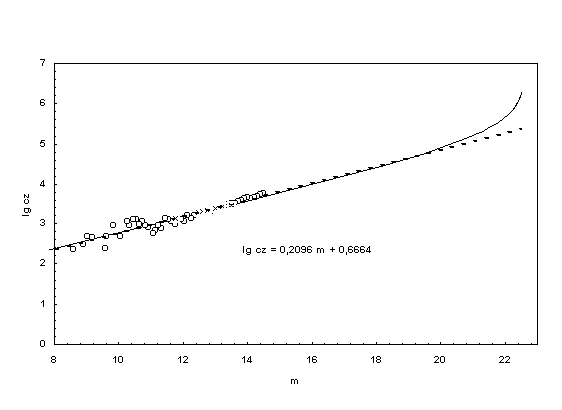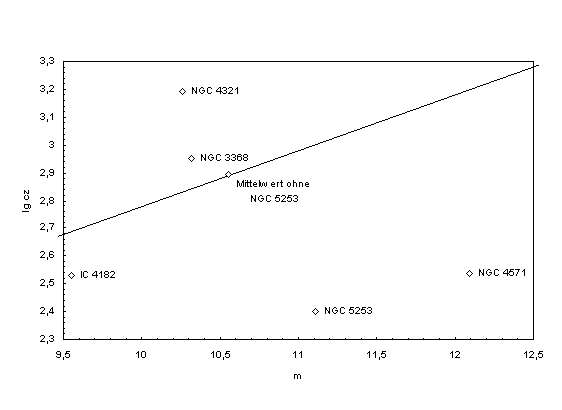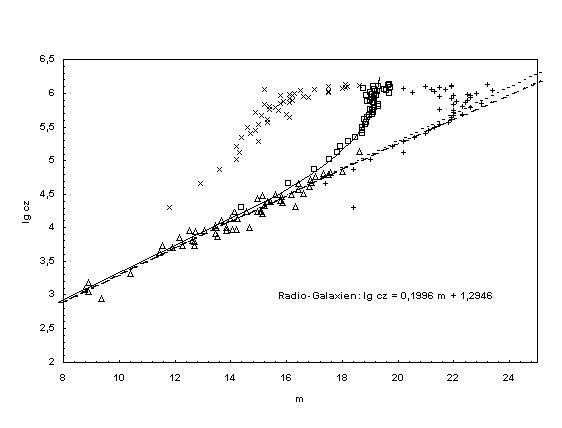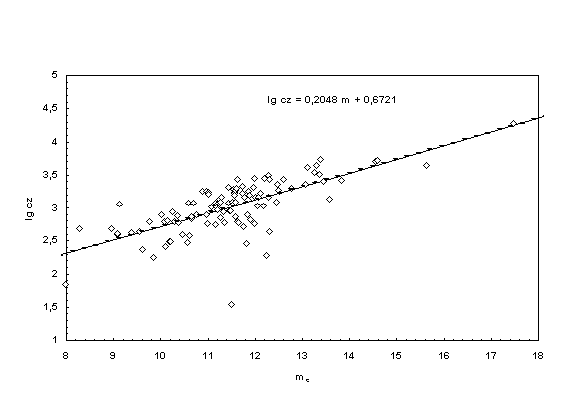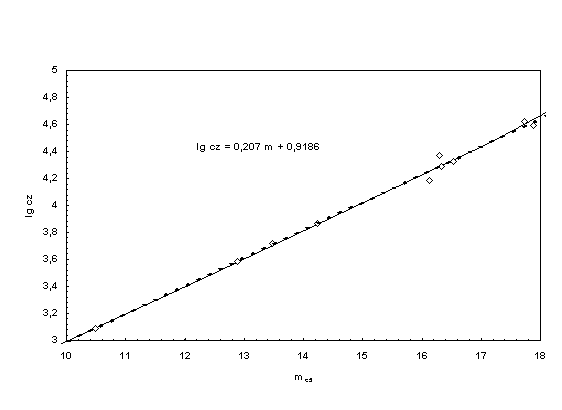ABOUT SEVERAL
PROBLEMS OF MODERN COSMOLOGY
I. ABOUT THE INTERPRETATION OF
THE HUBBLE DIAGRAM
by Steffen Haase, Leipzig, Germany
1. DERIVATION OF THE
REDSHIFT-MAGNITUDE RELATION
ABSTRACT
In the Euclidean space the way covered by a
photon between an earthly observer and any galaxy is used as the dynamic
distance between the two. Due to this approach a mean apparent limit magnitude
of galaxies amounts to mA = 22.62. This corresponds to a present
maximum distance of DA = 3206 Mpc, assuming that the mean absolute
magnitude for galaxies is M = -19.91 in the first approximation. In this case
the present Hubble parameter is HA = 62.34 km s-1 Mpc-1
and the corresponding Hubble time tH = 15.7 x 109 years.
The present density of the visible part of the universe is rA = 7.3 x 10-30g cm-3. The
mass corresponding to DA amounts to MU = 2.96 x 1055g.
For the mean absolute magnitude of the quasars MQ = -23.07 is found.
Subject headings:
cosmology: distance scale - cosmology: theory - galaxies: distances and
redshifts - quasars: general
The easiest model for the universe
results from the assumption of a homogeneous and isotropic distribution of
matter in the universe in accordance with the cosmological principle. This
assumption leads to the solution of Einstein's field equations with the help of
the Robertson-Walker metric (RWM)
(1) 
where S(t)
denotes the time depending scale factor (also called radius of the universe)
and c the speed of light. The curvature constant e can be ±1 or 0. The consideration Consideration of
the dimensions shows that S can be measured in centimeter or Mpc. The comoving
radial distance coordinate r as well as e are without dimension.
In the following the curvature constant e is always set to be zero always.
Therefore the further considerations are only valid for the case of the flat
Euclidean space. This procedure is justified by the good correspondence between
the theoretical results and the measuring results of astrophysics which is
shown in section 2.
For
time-dependent measurable distances the RWM delivers
(2) 
if
e = 0 is taken into account. R(t) = S(t)r
describes the physical distance from the coordinate origin r = 0 and the
dimension of r is also that of a length. The change of the speed of distance changingis
calculated to by dR/dt
(3)
![]()
The
last equals sign is valid because of dr/dt = 0 for the extra galactic systems
which forms
the substratum of the universe. These cosmic objects don't show any proper
motions, i.e. they rest in the substratum. This is an immediate result of the
cosmological principle which is used in the frame of cosmology: The universe
always remains homogeneous and isotropic in the course of its development.
The time-dependent spherical volume
belonging to R(t) is expressed through
(4) 
if also here e = 0 is also taken into account. The mass containing
contained
in this volume is given by
(5) ![]()
With
r(t) the time-dependent matter density was
introduced. This mass remains time constant during the expansion of the
universe.
The physical distance between two
extragalactic objects picked out arbitrarily and being at the comoving radial
coordinate places r1 and r2 for a particular but
arbitrary time t (e.g. today) is calculated through
(6) 
if neither of the two objects is in
the coordinate origin (for e = 0). It is now easy now to
see that a photon moving independently of the substratum covers the following
way between two such galaxies
(7) ![]()
if tE is called the emission
time and the absorption time is
marked by tA. For the
place of the emission the index Q (light source) was introduced and for the
absorption place the index became S (light sink). A simplified expression for
the physical quantities that are used here was is introduced
behind the last equals sign. It is this light path which has to be taken into
account as the apparent distance between two extra galactic systems to calculate
the red shift distance relation. This light path is responsible for the
weakening of light which finds its expression as apparent magnitude. The light
path which was defined with equation (7) is not neither identical
with the today's distance (RSA -
RQA) of between both galaxies and nor equals also not with the
distance D with (RSE - RQE) between the galaxies at the
time of emission of the observed photon.
A
maximum possible path is given by S(tE) = 0 and rQ = 0,
respectively. In this case Dmax = RSA is valid. Since RQE
is generally different
from zero in generally case, as a rule the
emission place of the photons isn't in the coordinate origin but someplace
somewhere
between him it and the galaxy, within the photons are
observed.
For
a particle moving force-free and radial in the matter distribution the
conservation law arises from the geodesic equation
(8) ![]()
i.e. the product of impulse amount p
and world radius S is always constant. From this a redshift z follows for
photons with the impulse p = Sw/c corresponding to
(9) ![]()
SA is the value of the
world radius at the time tA of the absorption (index A) of the light
particle in the measuring device and SE is the size of the world
radius at the time tE of the emission (index E) of the photon.
It is the aim of the following
considerations to calculate a relation between the redshift z and the apparent
distance D. After this D will be exchanged using the apparent magnitude m.
Since
a free photon always moves with the constant light velocity c through the
Euclidean space (the matter distribution of the universe), the path covered by
it during the time between its emission and absorption is given by
(10) 
For the description of the movement
of the galaxy within the observer stays the
Friedmann differential equation
(11) ![]()
is used, which is given when solving
Einstein's equations with the help of the RWM. This equation describes the time
development of the scale parameter and all physical distances in the universe,
respectively. For the confirmation of the last-named statement dS/dt is
replaced by dR/dt and S by R in accordance with the equations (2) and (3):
(12) ![]()
For the mass M which remains
constant during the cosmic expansion equation (5) is valid. Therefore the
Friedmann equation is converted to
(13) ![]()
The integration Integration between in
thesuitable boundaries limits yields
thereupon
(14) ![]()
RSA was selected as the
upper bound of the path integral since the photon and the observer meet at this
place at the time tA. It is noticed to be noted here
that R in equation (13) describes the surface of a (Friedmann-) sphere because
of using the mass-conservation law (5) during the derivation of this equation.
This sphere includes the whole mass M completely. Therefore the observer
considered here is on the surface of this matter sphere.
On
equating the time intervals of the equations (10) and (14) we get for the way
which is covered by the photon
(15) 
where the unknown physical location RSE
of the observers galaxy at time of the photons emission is still to be
eliminated. The relations RSE = SErS and RSA
= SArS are very useful, since r = rS for
time tE and tA (space expansion because of the time
development of S):
(16) 
Using equation (9) we get the following
intermediate result for the distance-redshift relation we seek for
(17) 
where the factor contains the Schwarzschild
radius RS = 2MG/c2 of the mass M which is constant for
the observer. According to A. Friedmann the conservation law for this mass is
(18) ![]()
Finally this gives the distance-redshift
relation
(19) 
assuming that the limit distance
(19a) ![]()
is introduced for the factor, which mainly
depends on the current density rA in the universe only. For this distance z = ¥ is achieved. Besides because of
equation (17) it is
(19b) ![]()
There is such a limit distance in all steps of
the development of the universe, where its size is constantly increasing
because of the expansion with time.
The transition to the apparent
magnitude m with the help of the well known relationship (A is a constant)
(20) ![]()
gives the equation
(21) 
if an apparent magnitude, which corresponds to
the present value of DA, is introduced. This equation only depends
on the parameter mA, which can be fixed by comparing it with a
Hubble diagram. Since a Hubble diagram consists of a number of extragalactic
objects this comparison gives always a mean value for the apparent magnitude mA.
Therefore the related absolute magnitude MA has the meaning of an
average value too. Thus the average apparent magnitude mA belongs to
a cosmic object with an average absolute magnitude MA and distance DA.
However, note that the light which was emitted from such an object is infinite
red-shifted according to equation (19) and (21), respectively, while arriving
at the observer.
The introduced apparent magnitude mA
has the meaning of a limit for present measuring observer and explains the
missing of even larger values of m which are caused by the distance. Thus the
cut-off effect in the right part of the Hubble diagram is caused by the limited
value of the present DA (see e.g. Djorgovski, Spinrad & Marr
1985, fig. 1 and Yoshii & Takahara 1988, fig. 3 with the explanation: 'The
sample galaxies have almost a constant magnitude of VSM 22-23 mag
over the range of z'). Because of the average value nature of the apparent
magnitude mA we will find objects at the right and left hand side of
mA in the Hubble diagram especially for large redshifts.
The curvature of the curve in the
Hubble diagram according to equation (21) for large values of the apparent
magnitude is an immediate expression of Friedmann's law of expansion (12). It
shows that the speed dR/dt at the beginning of the expansion was very large,
and that the deceleration of this moving was at that time essentially larger
than at later times.
In equation (20) and thus also in
the following equations the multiple consideration of the redshift in the form
of two (1+z)-factors in the denominator is deliberately neglected (compare with
e.g. the derivation of the Hubble law by Sandage 1995). Because of the space
expansion during the light travel time the way covered by the photon in the
direction of the observer is simply stretched. This process of light
attenuation is complete taken into consideration because of the combination of
equations (19) and (20). Because of the good agreement of equation (21) with
the measurement results both Robertson factors are actually superfluous.
Combining the apparent limit
magnitude mA with the absolute magnitude M, we get for DA
the equation
(22) ![]()
where DA is measured in parsec.
Since mA follows on principle from the Hubble diagram, an
independently determined mean absolute magnitude of a star system is enough, to
compute DA. Given DA, using
(23) 
the corresponding absolute magnitude can be
calculated for each cosmic system, whose z and m are measured. Inserting the
distance module into equation (23) gives directly DA, assuming z is
also known.
Note that the redshift term of equation (23)
deviates considerably from those of equation
(xxx) ![]()
which can be found in the literature (see e.g.
Sandage 1995). This is true especially for large redshifts. Moreover the
equation (xxx) does not describe correctly the location of quasars in the
Hubble diagram.
Using different spectral ranges (mpg,
U, B, V, R, I, J, H, K, L, bJ, bF, ...)
corresponding different apparent magnitudes (mpgA, UA,
BA, VA, RA, IA, JA, HA,
KA, LA, bJA, bFA, ...) are
expected. This leads to different mean absolute magnitudes.
However not all of the spectral
ranges show the theoretical expected slope in the linear part of the Hubble
diagram. This fact obviously indicates development effects in the corresponding
spectral ranges. Measuring results, which use these spectral ranges, should not
be used for evaluation with the help of the here given equations since
development effects were not taken into consideration while deriving the
equations.
A further important quantity of
cosmology is the Hubble parameter. Eliminating z in equation (19) gives
(24) 
and developing this relation for small ways of
light D, yields
(25) ![]()
where HA is the present Hubble
parameter.
The interesting thing at equation
(25) is the factor 2/3, which is shown by comparing the theory with the
astrophysical measuring results. This factor is responsible for the good
correspondence between the upper limit of the theoretical "age of the
universe" and the age of the spherical cluster of stars.
Note a possible understanding
problem relating the common usage of equatios (12) and (5): Using Friedmanns
equation (12) and the conservation law of mass (5) means, that the observers
galaxy is always situated on the surface of a sphere, which is enclosing the
whole mass M, and whose mass density r(t) changes continually with time. This density
is constant at any time at all locations as well. Otherwise the conservation
law of mass should not be used in the form with r ¹ r(R), since a decomposition of the
considered mass into volume and mass density according to equation (5) is only
valid for a density, which is independent from the distance R. Because all
observers in the universe are equal according to the cosmological principle,
each observer is situated on the surface of its own virtual sphere. Since he
can as well look in any direction and always will find mass (for instance in
form of shining cosmic systems) there, he is surrounded by a multiple of such a
virtual spheres which can be theoretical cut out of the universe (and of course
partly overlap). The center points (R = 0) are always situated in a distance,
which corresponds to the current radius DA of the mass sphere. If
this imagination will be not accepted in this form from the universe which is
visible for us, then the Friedmann equation is not useful for the solution of
cosmological moving problems in connection with the conservation law of mass,
because the Friedmann equation just describes a single mass sphere with a
strongly limited surface and radius respectively. Beyond such a surface there
is as everybody knows no mass. During the proposed calculation it was shown,
that the current radius DA of this sphere is always the current
maximum possible way of light between the light source and the observer. Hereby
we just get the limitation of the observable magnitudes of cosmic systems for
any time of expansion.
2. COMPARISION WITH ASTROPHYSICAL
MEASUREMENTS
In the literature we can find a
multitude of Hubble diagrams. Here the combination by Huchra et al. (1983) is
used, to determine the parameter mA. Since the CfA-catalogue is
m-limited, equal m-intervals were formed to evaluate this catalogue of galaxies
and the corresponding m- and cz-mean values were determined. The result is
shown in Fig. 1, where the mean values are represented by
circles. Fitting the theory to the dashed line of best fit through the mean
values gives mA = 22.62. This apparent magnitude has the nature of
an average value and using equation (22) an average absolute magnitude MA can
be assigned to assuming that the limit distance DA is known.
Besides Fig. 1 shows some galaxies
of the used catalogue which are represented by crosses and nearly correlated
with the best curve. These are the NGC objects 4754, 4608, 4532, 520, 3320,
3888, 1032, 3788, 4224, 3876 as well as 3869. NGC 4754 with m = 11.77 and log
cz = 3.138 is the best of these galaxies to obtain agreement with the theory,
because it is the apparent brightest compared to the others. For this object
the resolution of cepheids is perhaps possible to find the distance module.
Because there are no distance
modules of one of the mentioned objects available, we searched the literature
to find well known distance modules. These values were then combined to a
Hubble diagram for the cosmic systems M100 = NGC 4321 (Freedman et al. 1994),
M96 = NGC 3368 (Tanvir et al. 1995), NGC 5253 (Saha et al. 1995), NGC 4571
(Pierce et al. 1994) and IC 4182 (Sandage et al. 1992), as shown in Fig. 2. Measurements which were not found in this literature were
taken from the articles by Huchra et al. (1983), Kraan-Korteweg & Tammann (1979) and Sandage & Tammann
(1975). Fortunately the
object, which was formed by taking the mean value of the measurements without
consideration of NGC 5253, is very close to the theoretical curve fitted with mA
= 22.62. For the mean object we get the absolute magnitude M = -19.91, the
apparent magnitude m = 10.56 and the redshift cz = 785.3 km s-1,
which corresponds to log cz = 2.9. Since mA and M are known in a
first approximation, the physical quantities DA, HA as
well as rA and the mass MU can be
determined. With the help of equation (22) we get DA = 3206 Mpc. With
this value the Hubble parameter amounts to HA = 62.34 km Mpc-1
s-1. This leads to a Hubble time of tH = HA -1
= 15.7 x 109 years. Thus there is almost no discrepancy to the
assumed age of the oldest spherical star clusters (compare with e.g. Bolte
& Hogan 1995). Using equation (19a) we get the current mean density of the
visible part of the universe (sphere with radius DA) rA = 7.3 x 10-30 g cm-3.
Thus the expanding sphere has a mass of MU = 2.96 x 1055 g.
This mass covers all the components of the metagalaxy which are capable of
gravitation: mass from usual particles, radiation and all of the other forms of
energy. - If we calculate RSA with MU and equation (19b),
we get RSA = DA, i.e. DA can be used instead
of RSA in all given formula!
The given values can just be considered as a first approximation, because the calculated mean object lies not exactly on the theoretical curve, and the data are in logarithmic form. Even an insignificant change of one of the input quantities implies relative large shifts of the calculated values. Besides the calculation of the mean value M from only 4 extragalactic objects is critical from a statistical point of view. - Because just the principle of finding the theoretical derived parameter should be explained, no approximations of error limits are given.
In Fig. 3 the
theory is compared with the Hubble diagram of radio galaxies (triangles)
according to Sandage (1972). To note the meaning of the new theoretical
relations for the quasars this figure shows mean interval values of 13214
quasars (squares) according to Vèron-Cetty et al. (2000). The dotted line is
the curve of best fit only through the radio galaxies. With the help of
equation (23) the theory was fitted to the quasars, whereby we get a mean
absolute magnitude of about MQ = -23.07 for these cosmic objects.
Fitting the theory to the radio galaxies gives an absolute magnitude of MRG
= - 22.8 (Sandage determined M = -22.98 for H0 = 50 km s-1
Mpc-1). The dashed line corresponds to the conventional theoretical
derivation of the Hubble law for a deceleration parameter of q0 =
0.5 assuming that the free available constant is fixed with the help of the
galaxies of the CfA catalog [see equation (xxx)]. It is impressive that the new
derived theoretical curve goes exactly through the average values of the
quasars. Hereby the problem of radiation power of quasars which was so long
assumed to be very large can be qualified. On average these objects are not
significantly absolute brighter than the radio galaxies. However it shows that
the absolute magnitude of quasars varies considerably around the value MQ.
In order to get a better understanding the Hubble diagram shows also the
minimum (plus signs) and the maximum (crosses) apparent magnitudes within the
intervals. Moreover evaluating this Hubble diagram shows that the redshift
could be used as an distance indicator for these quasars, whereas the apparent
magnitude is not suitable. Note that equation (xxx) for the Hubble diagram
found in the general literature fails at all in the area of large redshifts.
A comparison of the theory with two
original Hubble diagrams (Hubble 1936) will be given too. Fig. 4 shows,
that the measuring results of field galaxies already listed by Hubble well
correspond to the values of modern astrophysics (mA = 22.3). Fig. 5 gives a mean absolute magnitude of M = -21.6 for the mean
values of the brightest cluster galaxies, assuming DA = 3206 Mpc.
REFERENCES
Bolte, M.,
Hogan, C.J., 1995, Nature, 376, 399
Djorgovski,
S., Spinrad, H., Marr, J., 1985, in New Aspects of Galaxy Photometry, Lecture
Notes in Physics 232, 193, ed. Nieto, J. L., (Berlin: Springer Verlag)
Freedman, W. L., et al.,
1994, Nature, 371, 757
Hubble, E., 1936, ApJ, 84,
270
Huchra, J., Davis, M.,
Latham, D., Tonry, J., 1983, ApJS, 52, 89
Kraan-Korteweg, R. C.,
Tammann, G. A., 1979, Astronomische Nachrichten, 300, 4,
181
Pierce, M. J., Welch, D.
L., McClure, R. D., van den Bergh, S., Racine, R., Stetson, P. B., 1994,
Nature, 371, 385
Saha, A., Sandage, A.,
Labhardt, L., Schwengeler, H., Tammann, G. A., Panagia, N., Macchetto, F. D.,
1995, ApJ, 438, 8
Sandage, A., 1972, ApJ, 178,
25
Sandage, A., Tammann, G.
A., 1975, ApJ, 196, 313
Sandage, A.,
Saha, A., Tammann, G. A., Panagia, N., Macchetto, D., 1992, ApJ, 401, L7
Sandage, A.
R.: in The Deep Universe, Saas-Fee Advanced Course 23, Lecture Notes 1993,
edited by B. Binggeli and R. Buser, Springer Verlag, 1995
Tanvir, N.
R., Shanks, T., Ferguson, H. C., Robinson, D. R. T., 1995, Nature, 377,
27
Véron-Cetty,
M.-P. Véron, P.: A Catalogue of Quasars and Active Nuclei, 9th edition, March
2000, http://www.obs-hp.fr or A&AR (in press)
Yoshii, Y.,
Takahara, F., 1988, ApJ, 326, 1
FIGURES:
|
Figure
1. Hubble
diagram according to Huchra et al. (1983). The circles represent the mean
values of m-intervals and the crosses show the best galaxies. The dashed
straight line is the curve of best fit through the mean interval values of
galaxies. The continuous line corresponds to the new theory with mA
= 22.62. |
|
|
Figure
2. Hubble
diagram according to Freedman et al. (1994), Pierce et al. (1994), Saha et al. (1995), Sandage et al. (1992)
and Tanvir et al. (1995)
as well as Sandage & Tammann (1975), Kraan-Korteweg & Tammann (1979)
and Huchra et al. (1983) to form a mean value object. The continuous line
corresponds to the new theory with mA = 22.62. For further
explanations see text. |
|
|
Figure
3. Hubble
diagram for radio galaxies according to A. Sandage (1972) and quasars
according to M.-P. Véron-Cetty (March 2000). The curved continuous line
corresponds to the new Hubble relation, which was fitted to the mean interval
values of the quasars (squares) with MQ = -23.07. The dashed line
corresponds to the traditional theory. It was fitted to the radio galaxies
(triangles). The dotted line is the curve of best fit through the radio
galaxies. The crosses on the left hand side of the figure are the maximum
apparent magnitude per redshift interval, while the plus signs on the right
hand side represent the minimum apparent magnitude of the quasars. On average
the quasars are with MQ = -23.07 only a bit brighter than the
radio galaxies, for which was found MRG = -22.8. |
|
|
Figure
4. Redshift-magnitude
diagram for field galaxies according to Hubble (1936). The curve of best fit
(dashed straight line) gives mA = 22.3. Here the new theory
(continuous line) was k-corrected with a selective term only. |
|
|
Figure
5. Redshift-magnitude
diagram for the mean values of the brightest cluster galaxies according to
Hubble (1936). The curve of best fit (dashed straight line) gives a mean
absolute magnitude of M = -21.6 for mA = 22.62 and DA =
3206 Mpc. The theory (continuous line) was k-corrected with a selective term
only. |
|
Copyright
by Steffen Haase, Leipzig, 1998 and 1999
Last
update: 03/01/2005
Last correction of spelling mistakes: 11/26/2005
